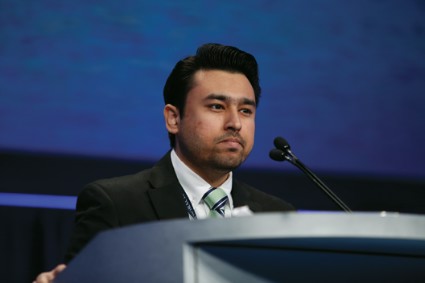User login
Diabetes has historically been associated with greater mortality and more and worse postoperative complications after coronary artery bypass grafting (CABG). Researchers continue to search for improved surgical techniques and other options to improve CABG outcomes in diabetic patients.
The use of bilateral internal thoracic artery (ITA) grafting and complete revascularization was found to improve the results of CABG in patients with diabetes, according to the results of an assessment of nearly 12,000 diabetic patients who underwent surgical revascularization, according to Dr. Sajjad Raza, a research fellow in cardiac surgery, who presented the results of a study that he and his colleagues performed at the Cleveland Clinic.
Patients who were operated upon from January 1972 to January 2011 were included in the study.
"Our research was designed to identify surgical revascularization techniques that can improve early and late results in patients with diabetes undergoing CABG," said Dr. Raza at the annual meeting of the American Association for Thoracic Surgery.
Surgical revascularization techniques investigated comprised single (71%) and bilateral (7.9%) ITA with or without other grafts vs. the use of saphenous vein grafting alone (SVG, 21%), as well as incomplete (18%) vs. complete revascularization, and the use of off- (5.0%) vs. on-pump CABG. The median follow-up was nearly 8 years, with total follow-up of more than 100,000 patient-years, according to Dr. Raza.
Multivariable analysis was performed to assess the effect of surgical techniques on early and late mortality.
After adjustment for patient characteristics, single ITA grafting with or without other grafts vs. SVG alone was associated with a 43% decrease in early mortality and 17% decrease in late mortality. The use of bilateral ITA grafting with or without other grafts led to a 60% decrease in early mortality and a 33% decrease in late mortality, with all hazard ratios being within their confidence intervals, and hence significant, said Dr.Raza.
In addition, bilateral ITA grafting was found to be significantly more effective than single ITA grafting in decreasing late mortality in patients with multisystem disease.
Incomplete revascularization was not found to be associated with increased early mortality, but was significantly associated with a 10% increase in late mortality The use of off-pump vs. on-pump CABG had no statistically significant effect on early and late mortality, Dr. Raza added.
"Overall, bilateral ITA grafting and complete revascularization improved results of CABG in diabetics. These surgical techniques should be used in diabetics undergoing CABG," Dr. Raza stated.
In an interview, commenting on the significance of the research, Dr. Raza added: "Diabetes is an emerging epidemic affecting nearly 382 million people worldwide. Because it is a risk factor for development of coronary artery disease, the number of diabetics undergoing coronary surgery has increased to nearly 50% of all patients undergoing surgical revascularization today.
"We know from the BARI2D and FREEDOM studies that for diabetics with multivessel coronary artery disease, CABG results in better outcomes than medical therapy or percutaneous coronary intervention. However, what remains unclear is which surgical revascularization techniques improve the outcomes of CABG in patients with diabetes. Our study helps to answer this important question," he concluded.
Dr. Raza reported having no relevant disclosures.
Diabetes has historically been associated with greater mortality and more and worse postoperative complications after coronary artery bypass grafting (CABG). Researchers continue to search for improved surgical techniques and other options to improve CABG outcomes in diabetic patients.
The use of bilateral internal thoracic artery (ITA) grafting and complete revascularization was found to improve the results of CABG in patients with diabetes, according to the results of an assessment of nearly 12,000 diabetic patients who underwent surgical revascularization, according to Dr. Sajjad Raza, a research fellow in cardiac surgery, who presented the results of a study that he and his colleagues performed at the Cleveland Clinic.
Patients who were operated upon from January 1972 to January 2011 were included in the study.
"Our research was designed to identify surgical revascularization techniques that can improve early and late results in patients with diabetes undergoing CABG," said Dr. Raza at the annual meeting of the American Association for Thoracic Surgery.
Surgical revascularization techniques investigated comprised single (71%) and bilateral (7.9%) ITA with or without other grafts vs. the use of saphenous vein grafting alone (SVG, 21%), as well as incomplete (18%) vs. complete revascularization, and the use of off- (5.0%) vs. on-pump CABG. The median follow-up was nearly 8 years, with total follow-up of more than 100,000 patient-years, according to Dr. Raza.
Multivariable analysis was performed to assess the effect of surgical techniques on early and late mortality.
After adjustment for patient characteristics, single ITA grafting with or without other grafts vs. SVG alone was associated with a 43% decrease in early mortality and 17% decrease in late mortality. The use of bilateral ITA grafting with or without other grafts led to a 60% decrease in early mortality and a 33% decrease in late mortality, with all hazard ratios being within their confidence intervals, and hence significant, said Dr.Raza.
In addition, bilateral ITA grafting was found to be significantly more effective than single ITA grafting in decreasing late mortality in patients with multisystem disease.
Incomplete revascularization was not found to be associated with increased early mortality, but was significantly associated with a 10% increase in late mortality The use of off-pump vs. on-pump CABG had no statistically significant effect on early and late mortality, Dr. Raza added.
"Overall, bilateral ITA grafting and complete revascularization improved results of CABG in diabetics. These surgical techniques should be used in diabetics undergoing CABG," Dr. Raza stated.
In an interview, commenting on the significance of the research, Dr. Raza added: "Diabetes is an emerging epidemic affecting nearly 382 million people worldwide. Because it is a risk factor for development of coronary artery disease, the number of diabetics undergoing coronary surgery has increased to nearly 50% of all patients undergoing surgical revascularization today.
"We know from the BARI2D and FREEDOM studies that for diabetics with multivessel coronary artery disease, CABG results in better outcomes than medical therapy or percutaneous coronary intervention. However, what remains unclear is which surgical revascularization techniques improve the outcomes of CABG in patients with diabetes. Our study helps to answer this important question," he concluded.
Dr. Raza reported having no relevant disclosures.
Diabetes has historically been associated with greater mortality and more and worse postoperative complications after coronary artery bypass grafting (CABG). Researchers continue to search for improved surgical techniques and other options to improve CABG outcomes in diabetic patients.
The use of bilateral internal thoracic artery (ITA) grafting and complete revascularization was found to improve the results of CABG in patients with diabetes, according to the results of an assessment of nearly 12,000 diabetic patients who underwent surgical revascularization, according to Dr. Sajjad Raza, a research fellow in cardiac surgery, who presented the results of a study that he and his colleagues performed at the Cleveland Clinic.
Patients who were operated upon from January 1972 to January 2011 were included in the study.
"Our research was designed to identify surgical revascularization techniques that can improve early and late results in patients with diabetes undergoing CABG," said Dr. Raza at the annual meeting of the American Association for Thoracic Surgery.
Surgical revascularization techniques investigated comprised single (71%) and bilateral (7.9%) ITA with or without other grafts vs. the use of saphenous vein grafting alone (SVG, 21%), as well as incomplete (18%) vs. complete revascularization, and the use of off- (5.0%) vs. on-pump CABG. The median follow-up was nearly 8 years, with total follow-up of more than 100,000 patient-years, according to Dr. Raza.
Multivariable analysis was performed to assess the effect of surgical techniques on early and late mortality.
After adjustment for patient characteristics, single ITA grafting with or without other grafts vs. SVG alone was associated with a 43% decrease in early mortality and 17% decrease in late mortality. The use of bilateral ITA grafting with or without other grafts led to a 60% decrease in early mortality and a 33% decrease in late mortality, with all hazard ratios being within their confidence intervals, and hence significant, said Dr.Raza.
In addition, bilateral ITA grafting was found to be significantly more effective than single ITA grafting in decreasing late mortality in patients with multisystem disease.
Incomplete revascularization was not found to be associated with increased early mortality, but was significantly associated with a 10% increase in late mortality The use of off-pump vs. on-pump CABG had no statistically significant effect on early and late mortality, Dr. Raza added.
"Overall, bilateral ITA grafting and complete revascularization improved results of CABG in diabetics. These surgical techniques should be used in diabetics undergoing CABG," Dr. Raza stated.
In an interview, commenting on the significance of the research, Dr. Raza added: "Diabetes is an emerging epidemic affecting nearly 382 million people worldwide. Because it is a risk factor for development of coronary artery disease, the number of diabetics undergoing coronary surgery has increased to nearly 50% of all patients undergoing surgical revascularization today.
"We know from the BARI2D and FREEDOM studies that for diabetics with multivessel coronary artery disease, CABG results in better outcomes than medical therapy or percutaneous coronary intervention. However, what remains unclear is which surgical revascularization techniques improve the outcomes of CABG in patients with diabetes. Our study helps to answer this important question," he concluded.
Dr. Raza reported having no relevant disclosures.

